‘Star Wars: The Force Awakens’: How Practical — and CGI — Effects Revived the Millennium Falcon and Franchise
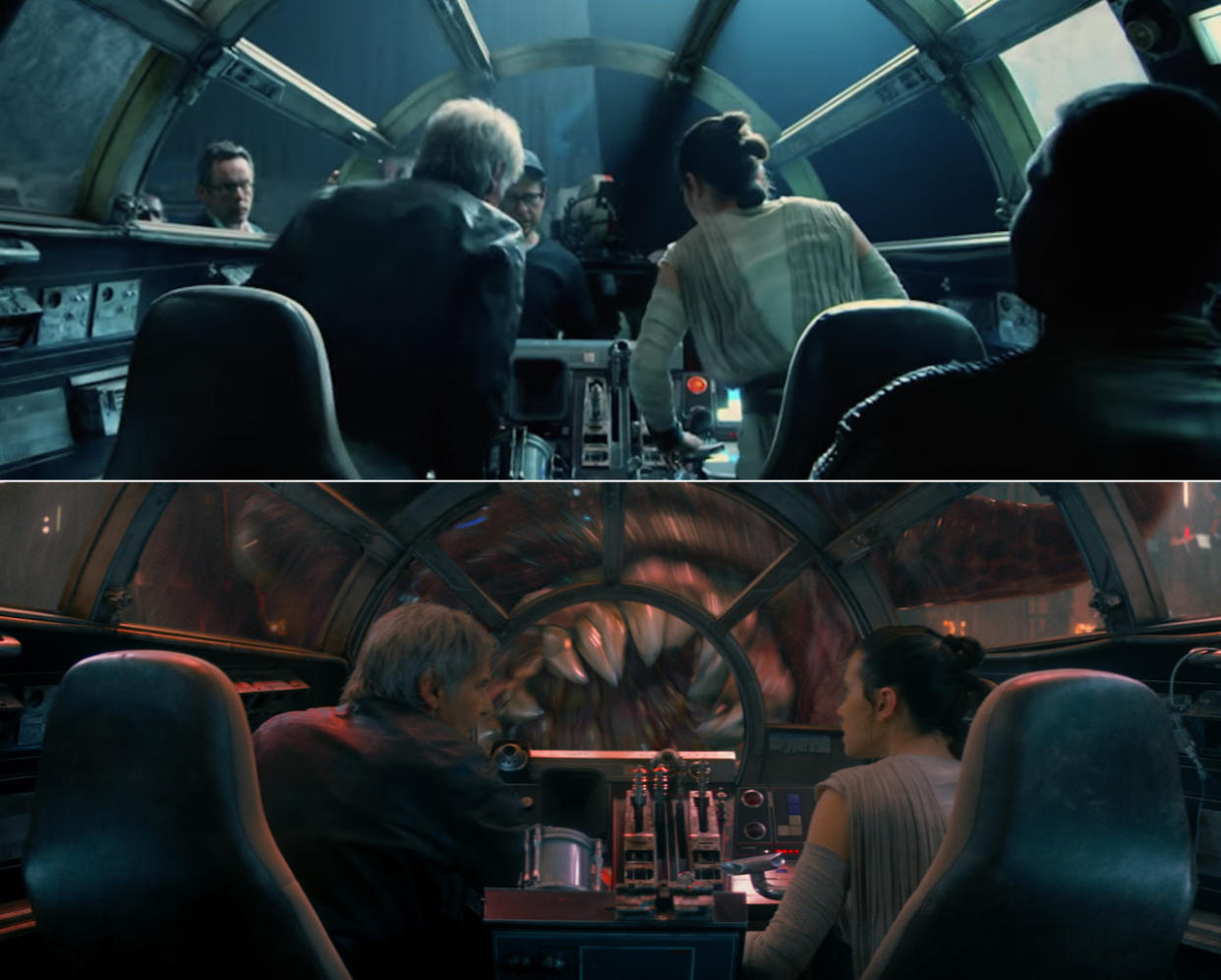
The newest Star Wars film, The Force Awakens, generated record levels of excitement by promising the old Star Wars: director J.J. Abrams brought back the franchise’s original stars and spoke endlessly of returning the magical “feel” of George Lucas’s first trilogy. A lot of the chatter, both from filmmaker and fans, centered on the revival of “practical effects,” which was code for more tangible creatures and space crafts in more physical environments. It would be a throwback, a link to the charming original films and nothing like the CGI-heavy prequels, the bastard stepchildren of Star Wars movies.
The truth is that while the plot of the new film adhered to the journey — in many places beat-for-beat — depicted in A New Hope, Abrams and his team were not exactly working with the now-ancient tools that Lucas and his team engineered in the ’70s. Of the nearly 2,500 shots in The Force Awakens, approximately 2,100 of them boasted visual effects of some kind — very many of them digital. The goal, according to Patrick Tubach, a VFX supervisor at Lucasfilm’s ILM, was to use enough real elements to trick the audience into thinking that the many digital add-ons were also physical matter.
“If we’ve done our job right, no one really thinks about the fact that we’ve done our job,” Tubach, whose VFX team was nominated for an Oscar on Thursday, told Yahoo Movies. “We take it as a compliment that people feel like it was all a practical thing. But whenever people sit down to think about it, there’s no way to make a Star Wars movie without visual effects; there wasn’t back in 1977 and there isn’t now.”
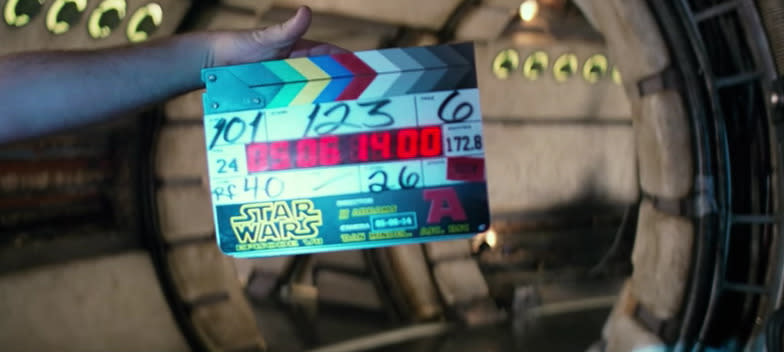
That’s especially so in an era in which green-screen sets and digital monsters have become the money-saving norm — why travel to an exotic location when you can render one on a computer? But with The Force Awakens, there was an unusual willingness to spend the time and money required to bring the actors (and thus the audience) on a more believable ride.
“It comes down to what is going to be good for the actors on set, and what is going to feel more tangible for the audience,” Tubach said. “I think you think a lot about interaction. If the actors are interacting with something, you absolutely want to try to build it for real if you can. You don’t want to create these odd situations where you’re having characters act to green screen or react to environment and a set that aren’t there. To be able to turn to an actual droid and have a conversation was huge for everyone.”
Related: Mind-Blowing ‘Star Wars: The Force Awakens’ Concept Art, From Kira to the Jedi Killer
Generally, digital elements were added in post-production, to extend and populate real locations (like the desert of Jakku) and sets built at Pinewood Studio in the U.K. (the Star Destroyer’s hangar and Starkiller Base in particular). Another strategy: use real, physical versions of props and planes enough (especially in close-ups) that when a scene required them to be created by a computer in post-production — like in action sequences — audiences didn’t think twice about any differences. “I think there are a lot of BB-8 shots that people would be surprised to know are digital,” Tubach admitted. “There are some shots of R2-D2 that people would be surprised to know are digital.”
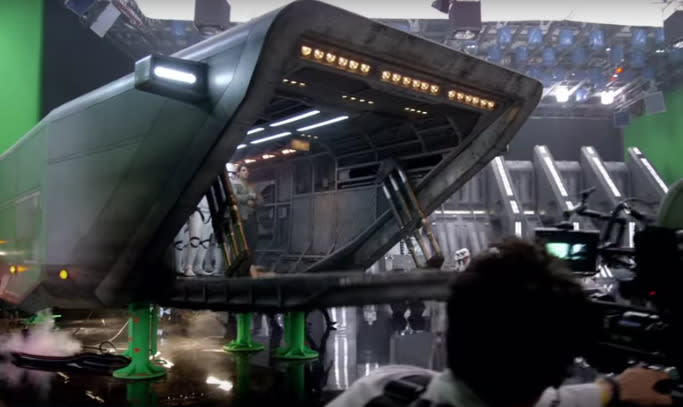
Poe and Stormtroopers on the set of ‘The Force Awakens’ (Disney/Lucas)
The same principle applied to the Millennium Falcon, which was being put on film for the first time since it helped bring down the second Death Star in 1983. They rebuilt the famous Corellian freighter, creating a faithful second-generation ship that — as Harrison Ford found out — was just as heavy as the original. The real difficulty came in trying to emulate the way that the original Falcon flew, getting its twists and turns and thrust to light speed just right; whereas the first trilogy used miniature models for these space sequences, ILM would be creating the images entirely with computers.
Related: These Hand-Made 'Star Wars: The Force Awakens’ Costumes and Collectibles Are Incredible
The prequels had plenty of ships — far more than the original films — and while there was no problem rendering them, they were too sleek and fast, blurs that behaved nothing like the first batch of transports that sailed smoothly and slowly against matte paintings set up on sound stages. To reclaim the feel of the earlier films, the VFX team took a trip into the past to better understand how to capture the original spaceship essence.
“We had access to all the Lucas archives,” Roger Guyett, another VFX supervisor at ILM, said. “They did a lot of research into the way the miniatures were constructed, the techniques they used, the colors, all that kind of stuff.”

Filming the rebuilt Millennium Falcon (Disney/Lucasfilm)
From there, they considered countless angles with regard to the physics of flight and the different space crafts, and how they would impact the actual physical environment already committed to film. Whether it was the Falcon, an X-wing, TIE fighter or Star Destroyer, they had to understand how the ships would respond to gravity and be maneuvered by pilots, all while keeping the past depictions in mind.
“The way that they move is absolutely critical to the way you might believe that these events are unfolding in front of you,” Guyett said. “How does an X-wing bank around, all that kind of stuff. We had long discussions about how an X-wing might settle down onto its undercarriage or bank around, or what kind of maneuver or how fast would it travel? Where would the spray go as it comes across the water?”
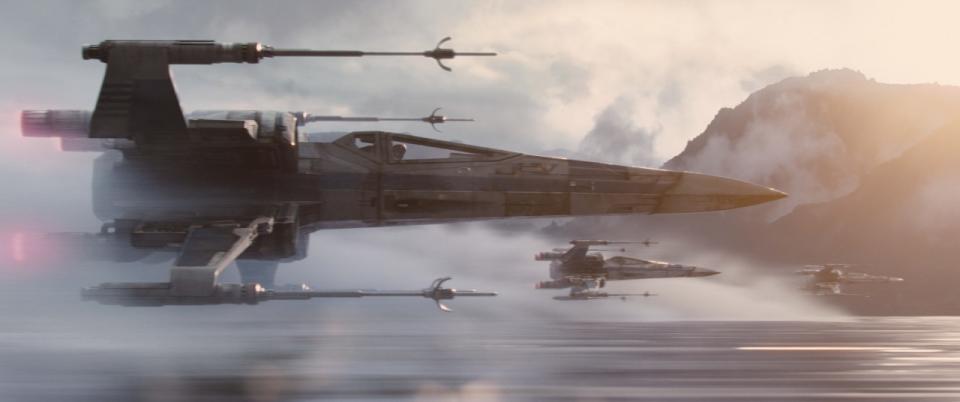
(Disney/Lucasfilm)
In accordance with the “used” future that made the first trilogy feel so lived-in, Guyett and his team considered every detail of the ships, “including how the paint surfaces might be a bit more worn around the engines,” he said, noting that, with a staff that grew up watching Star Wars, any inaccuracies or infidelities to canon would be flagged right quick. And, as powerful as ILM’s computers are, the VFX team was careful to concentrate on the physical movements of the miniatures themselves, and how they could recreate them, to give the audience the feeling that they were watching at least a relative of the first generation of vehicles.
“We researched how would they have photographed these scenes, where would they have mounted the cameras to the X-wings?” Guyett said. “I’m hoping that we showed some kind of restraint. And that doesn’t necessarily mean less exciting. I think it just means we were acutely aware of the language of the world we were creating, and you want to make sure you don’t overdo it. Just because you can do something doesn’t necessarily mean you should.”
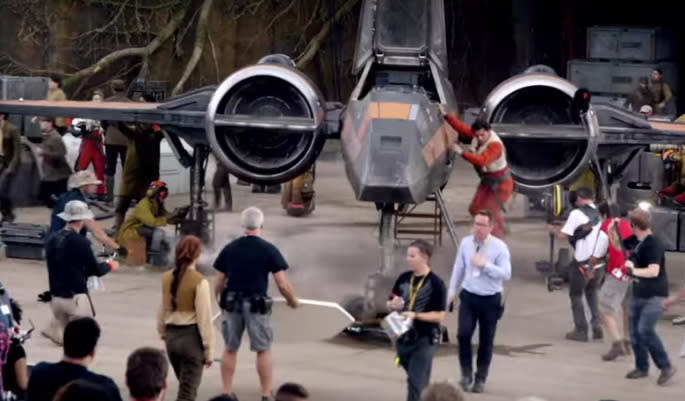
An X-Wing on the set of ‘The Force Awakens’ (Disney/Lucasfilm)
Those working in VFX on The Force Awakens are careful not to explicitly condemn the CGI-heavy visuals that fans seemed to reject during the prequel era — after all, ILM did those effects. Instead, the effects specialists focus on the lessons they’ve learned in the decade since, and how it could transport them further into the past.
“I think at the time [of the prequels] CGI was exciting to George, and George was always an innovator,” Tubach said. “And I’d never put words in his mouth, but I think he was always excited about what can you do with technology. And at the time he was excited that he could be free to create these words that didn’t exist. That’s one thing that drove our entire industry forward. But what we said was, there was a tangibility to those early movies that, because that stuff was there, it lent a lot of authenticity to things. So all we were doing was saying, how do you get back to that feeling? We reached a little further back in time and said what were the techniques that they used on those early films, and really tried to emulate those a little bit more than the newer films.”
Watch one of the biggest practical effects, BB-8, show how real he is:


